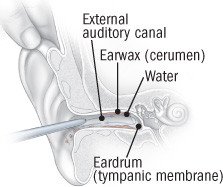Wax blockage of the ear canal
Medically reviewed by Drugs.com. Last updated on Feb 15, 2024.
What is Wax blockage of the ear canal?

In the outer part of the ear canal, cells produce a wax called cerumen that traps particles of dust and dirt. The wax also repels water, protecting the delicate eardrum from damage. The wax is moved outward gradually by the lining of the ear canal, carrying any dirt it has trapped. Eventually, the wax dries and falls out of the ear in small, unnoticeable flakes.
Normal production of earwax is healthy and good for your ears. If too much wax is being produced, it can block the ear, but more commonly, the ear becomes blocked because of improper ear care and ear cleaning. If you push cotton swabs, pencils, your finger or other objects into your ear canal to try to remove wax, the force can push the wax further into the ear and compress it against the eardrum. Earwax blockage, also called cerumen impaction, is a common cause of temporary hearing loss.
|
|
Symptoms
Your ear may feel stuffed or full, similar to the feeling some people get when they travel by airplane. You may have hearing loss that gradually worsens. Some people also experience earache or ringing in the ear (tinnitus).
Diagnosis
Your ear may feel stuffed or full, similar to the feeling some people get when they travel by airplane. You may have hearing loss that gradually worsens. Some people also experience earache or ringing in the ear (tinnitus).
Expected duration
If the blockage is removed, the problem goes away.
Prevention
Never put any objects into your ear canals. Cotton-tipped swabs should be used to clean the outer ear only. Do not place them in the canal.
Treatment
If you have had earwax blockage previously and recognize the symptoms, you can try treating the blockage at home before seeing a doctor. Several over-the-counter earwax removers are available.
If you think you may have a hole or tear in your eardrum, or if you have ever had surgery on your ear, do not try removing the blockage yourself because you could cause an infection.
Tip your head so the ear points toward the ceiling. Using a dropper, fill the ear canal with liquid earwax remover. Keep your head tipped for at least five minutes, then cover your ear with a towel and straighten your head so the liquid drips out. Repeat this process one to two times a day for the next few days. If this does not remove the wax, visit your doctor.
If you go to your doctor to have the wax removed, your doctor may flush, scrape or vacuum your ear, or he or she may prescribe an earwax softener that you can use at home. In some cases, you may need to visit a specialist to have the wax removed.
When to call a professional
If you have never had earwax blockage and are unsure what is causing the problem, visit your doctor. Other common causes of hearing loss include:
- exposure to repetitive loud noises, such as gunshots or trucks
- aging
- a tumor on the hearing nerve called an acoustic neuroma.
A doctor or nurse can help when home treatments fail to relieve a wax blockage. A doctor should treat your blockage if you have had a ruptured eardrum in the past.
Prognosis
Earwax blockages usually can be removed, and don't cause any lasting problems. Some people may have torn or perforated eardrums that require different treatment.
Additional info
American Academy of Otolaryngology—
Head and Neck Surgery
https://www.entnet.org/
Further information
Always consult your healthcare provider to ensure the information displayed on this page applies to your personal circumstances.

